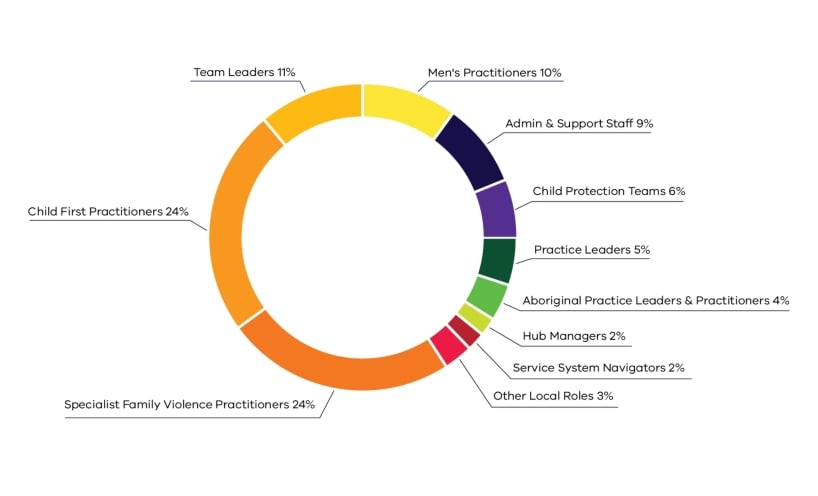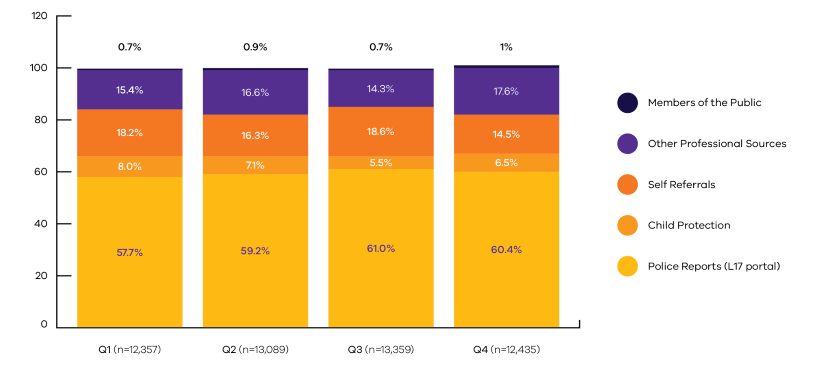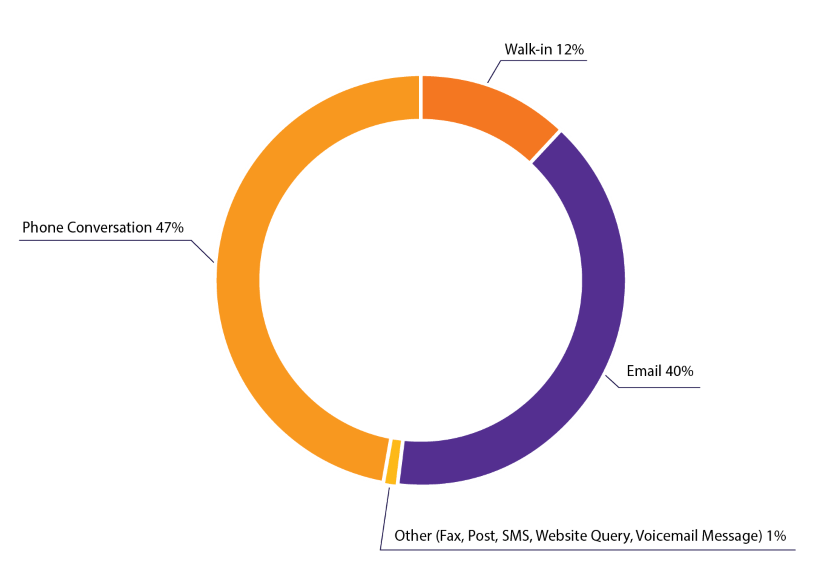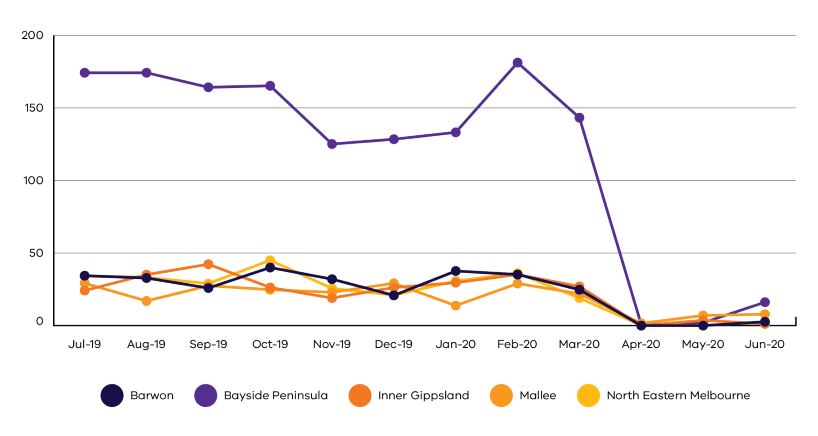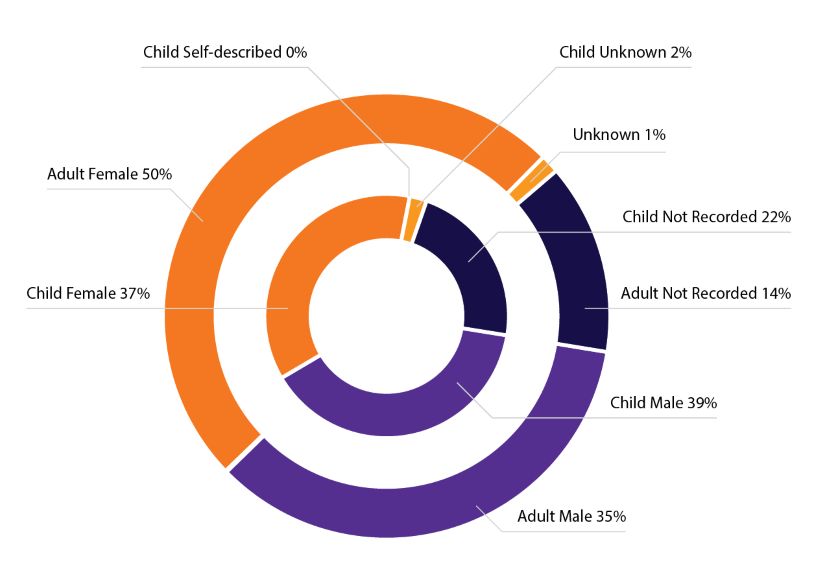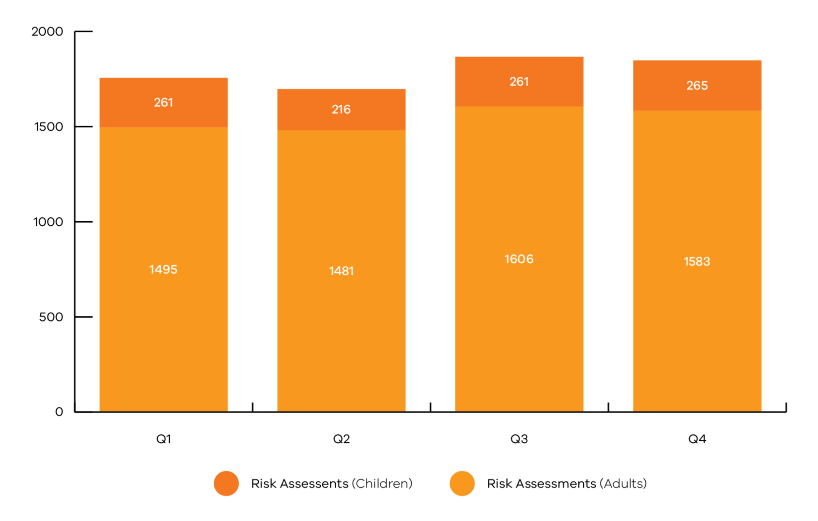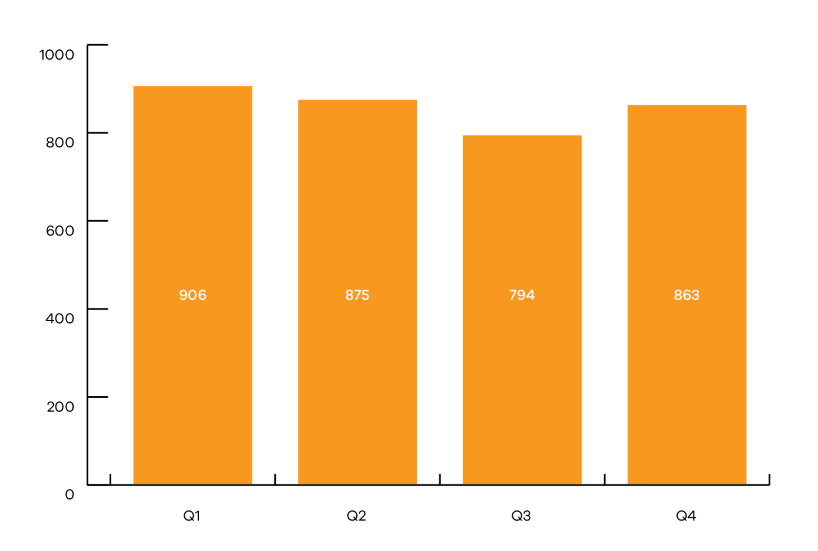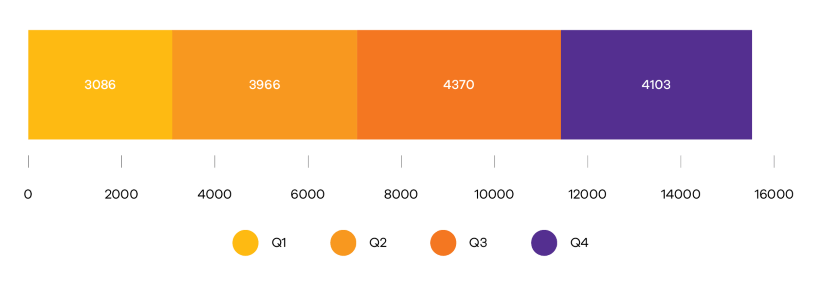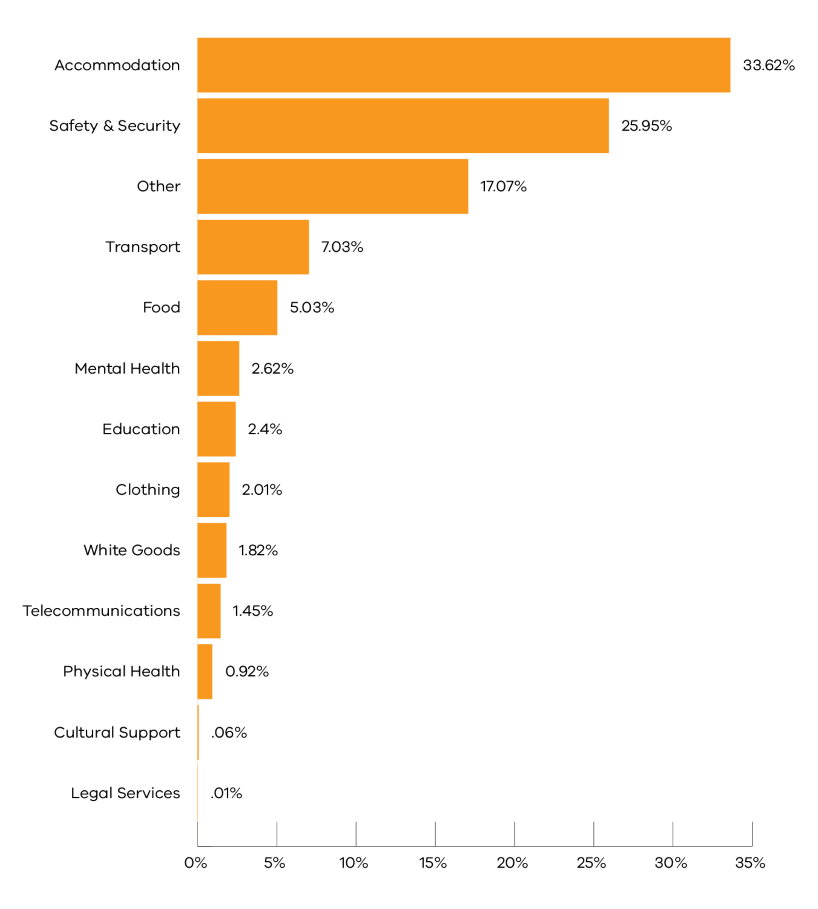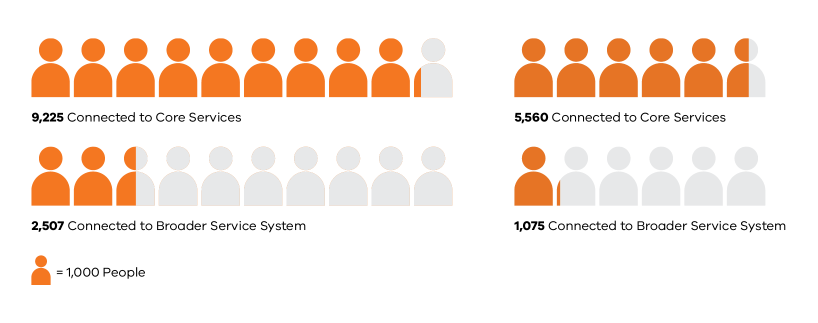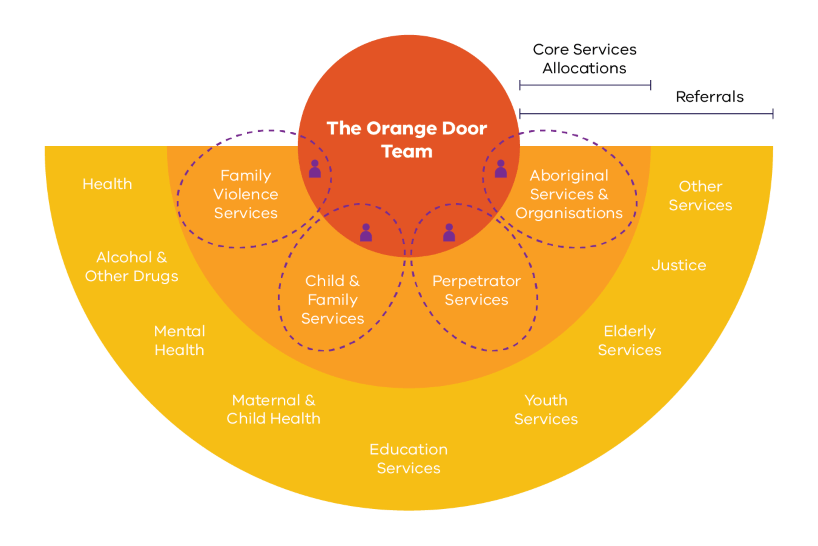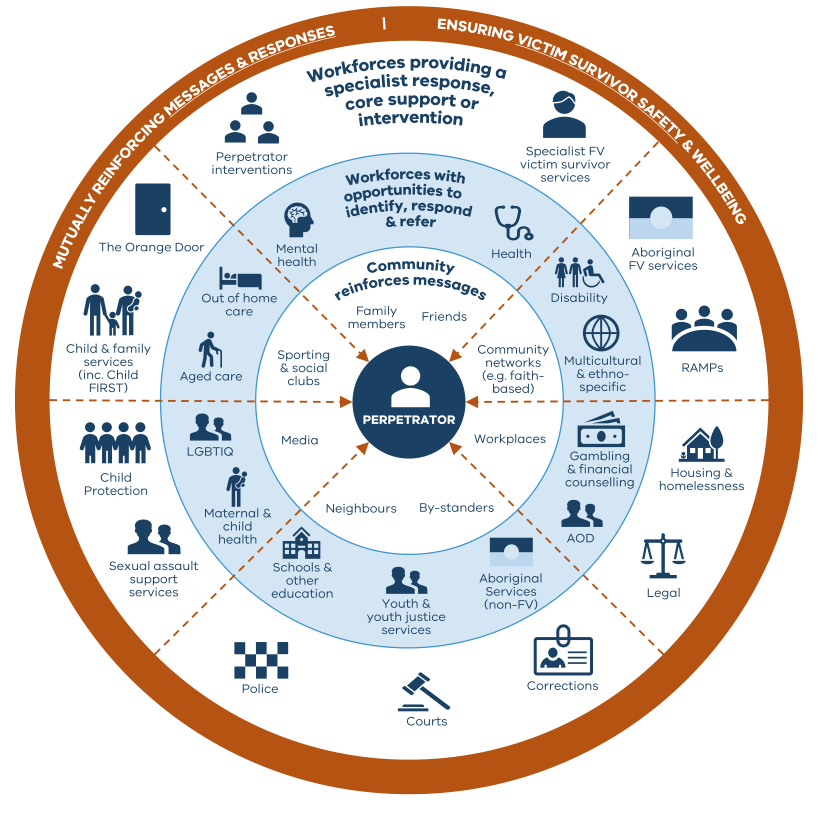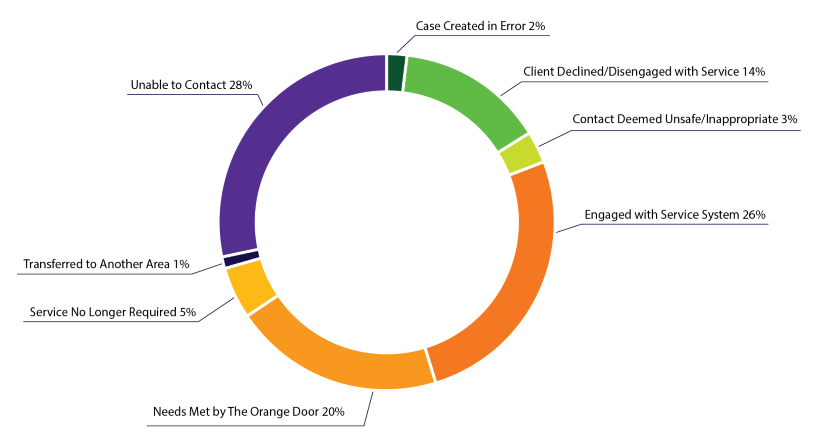- Date:
- 27 Apr 2021
Foreword from the CEO, Family Safety Victoria, Eleri Butler
This has been an incredible year to join Family Safety Victoria, inspired by the evident commitment to ensure family violence and the inequalities which underpin it are no longer tolerated.
I feel privileged to be part of an ambitious reform program which centres Aboriginal communities’ self-determination and strengths, and places the expertise of specialist services and people with lived experience at its heart.
The achievements outlined in this 2019-20 annual report for The Orange Door network, delivered in collaboration with our sector partners, are momentous because this is a new way for people to access help and support, and we are working in ways that have never been done before.
The achievements this year are all the more remarkable, given the coronavirus (COVID-19) pandemic outbreak part way through the year. The safety and wellbeing of Victorians remained foremost in our response, as we adjusted short and medium-term priorities to meet immediate service delivery support requirements, while also maintaining momentum towards establishment of The Orange Door network across the state.
Family Safety Victoria has led the work to implement The Orange Door network since 2017, in response to Royal Commission recommendations to provide integrated access to effective support and improve the experience of people seeking family violence and family services.
By bringing together specialist services for victim survivors, services for perpetrators of family violence, and services for children and families in need of support, the model introduced significant change and investment to the service system.
The Orange Door network now forms an integral part of the family violence and family services systems in Victoria. It provides an entry point into the continuum of service provision that aims to ensure there is no wrong door to access high quality, consistent and effective support for families and children in the community. This includes tailored support for women and children impacted by family violence, holistic support for Aboriginal families in local communities, help with the care, development and wellbeing of children, and work with perpetrators to manage risk and change behaviours.
By the end of 2019-20, The Orange Door network operated across 5 areas - Barwon, Inner Gippsland, North Eastern Melbourne, Bayside Peninsula and Mallee, which is the focus of this Annual Report. The data in this report provides us with an overview of how people accessed and were supported by The Orange Door network in its second year of operation.
Over 50,000 people directly accessed or were referred for support into The Orange Door network of services. The needs and risks facing more than 15,000 children and young people were identified and assessed. The majority (80%) of people who engaged with The Orange Door had their needs met or were able to be connected to another support service.
Towards the end of the year, we welcomed the publication of the Victorian Auditor General’s Office (VAGO) performance audit of The Orange Door, which began in July 2019. Their audit focussed on whether the hubs “are providing effective and efficient service coordination for women and children”. The final audit report Managing Support and Safety Hubs was tabled in Parliament on 27 May 2020.
We welcomed the Auditor’s recognition that we engaged and consulted extensively with specialists and services to inform early development and delivery of The Orange Door and have demonstrated commitment to learning from feedback received. We had no hesitation in accepting all 9 recommendations, and the resultant actions are central to our implementation plans for the next phase of rollout of The Orange Door network.
As VAGO acknowledged, this is a long-term program of reform to transform family violence service systems in Victoria. We cannot achieve this alone.
As we move into the next phase of delivery, we remain committed to effective collaboration with Peak bodies, services and people with lived experience, to ensure the system meets the needs of individuals and families across the state. The second evaluation of The Orange Door, scheduled for completion in 2022, will focus on impacts and outcomes for people using our services.
Despite recent challenges, future delivery of The Orange Door network continues at pace. The Central Highlands and Loddon areas commenced in October 2020, while The Orange Door network commenced in Goulburn in April 2021. Inner Eastern Melbourne, Ovens Murray, Southern Melbourne, Outer Gippsland, Hume Moreland, and Wimmera South West will be operational by the end of 2021 and Western Melbourne, Brimbank Melton and Outer Eastern Melbourne will commence in 2022.
I want to acknowledge how incredibly hard our teams and our delivery partners have worked locally and across the state, to establish and deliver this integrated service response in our communities. Effective collaboration with specialist family violence services, perpetrator services, children and family services, Aboriginal services, and targeted services for multi-cultural communities, is vital to our success.
This annual report demonstrates our collective commitment towards building a service system that is connected, inclusive and works together to help keep adults, children, and families safe.
Acknowledgement of Aboriginal Victoria
The Victorian Government proudly acknowledges Victorian Aboriginal people as the First Peoples and Traditional Owners and custodians of the land and water on which we rely.
We acknowledge and respect that Aboriginal communities are steeped in traditions and customs built on an incredibly disciplined social and cultural order.
This social and cultural order has sustained up to 50,000 years of existence.
We acknowledge the ongoing leadership role of the Aboriginal community in addressing and preventing family violence and join with our First Peoples to eliminate family violence from all communities.
The Orange Door: delivering family violence and children and family services reform
The Victorian Government has committed to implementing all 227 recommendations of the Royal Commission into Family Violence and to delivering on the vision described in Roadmap for Reform: strong families, safe children. A key recommendation of both was to establish a network of Support and Safety Hubs, now known as The Orange Door, across Victoria.
The Orange Door network provides a new way for adults, children and young people who are at risk of experiencing or have experienced family violence and families in need of support with the care, wellbeing and development of children and young people to access coordinated support.
The delivery of The Orange Door network is a key part of the ongoing reform of the family violence and the children and families service systems. These reforms aim to strengthen responses for victim survivors of family violence and create better outcomes for children and families, while also addressing perpetrator behaviour, and improving access to interventions that support behaviour change.
The Orange Door network is an integral part of the family violence and family services systems. It provides an entry point into the continuum of service provision that aims to ensure there is no wrong door to access high quality, consistent and effective support for family violence and children and families in communities.
The significant work undertaken across Government and the community sector, specifically our partner agencies, to build networks of safety and to connect services has been central to the successful implementation of The Orange Door. There continues to be an enormous commitment and effort by The Orange Door workforce and partner agencies delivering this new service model.
The coronavirus (COVID-19) pandemic response had a major impact on The Orange Door network during the first half of 2020 and required Family Safety Victoria (FSV) and our partners to prioritise service delivery and related critical activities to help keep people safe. Essential intake, assessment and safety planning was increasingly delivered over the phone or online during physical distancing/community containment periods. Face-to-face services continued to be provided for people assessed as high risk or with high support needs where it was assessed that other means of supporting and providing a service were insufficient or unavailable.
Coordination was maintained with workforces more likely to be in contact with families impacted by family violence and in need of child and family support, during the pandemic, such as primary healthcare workforces. FSV also developed a suite of Multi-Agency Risk Assessment and Management Framework (MARAM) practice notes to support professionals, including The Orange Door practitioners, to respond to increased family violence risk during the pandemic and to use technology safely.
Work to identify and progress establishment of The Orange Door network in the remaining areas continued throughout this period, with The Orange Door in Loddon and Central Highlands commencing operations in October 2020. Work to establish the remaining 10 areas by 2022 has also continued.
The VAGO performance audit conducted in 2019 made 9 recommendations focusing on project planning, management and governance, operational delivery, support for integrated practice, performance reporting and oversight, and continuous improvement. FSV welcomed each of these recommendations and the platform the report offers to collaborate with partner agencies to continue to improve The Orange Door implementation and service delivery.
Several actions to implement VAGO’s recommendations commenced in 2020. All the activities to respond to the recommendations will be incorporated into the 2020-21 Stage Plan and Implementation Plan for The Orange Door, which is also supported by an improvement plan developed with partner services and their peak bodies.
Hira’s story: accessing The Orange Door during COVID-19 pandemic
Despite the impact of the COVID-19 pandemic and restrictions to face to face service delivery, The Orange Door remained operational and continued to support people to access the safety and support they needed.
One such person who needed support was Hira, a 23-year-old woman of Somalian descent and 20 weeks pregnant when she came into The Orange Door. Hira* wanted to find out whether there would be someone there who would take the time to hear her story and work with her to meet her needs on becoming a new parent.
Hira had been born in Australia, but her family had decided that she needed to spend time in Somalia in a facility that she described as using physical punishment and control to rectify her ‘behaviour’. This experience had been distressing for Hira, and when she returned to Melbourne, prior to the COVID-19 pandemic she was subject to physical abuse from her extended family. Despite an Intervention Order being put in place against her uncle, Hira had been unable to find the support she needed to establish her own home away from her extended family.
Practitioners in The Orange Door who heard Hira’s story undertook a family violence needs and risk assessment. Emergency safe accommodation was a priority, along with providing funds to help meet her immediate practical support needs so that she would have enough to eat and did not have to return to her extended family’s home for clothing or belongings – as this would alert them to her plan to move away from them.
Hira agreed for the practitioner from The Orange Door to communicate with other support services – this included housing and youth services, and pre-natal services. By pro-actively making these connections, The Orange Door practitioner was able to make sure that these services were aware of and understood Hira’s specific safety and support needs and her history of trauma. This helped these services more effectively identify specific supports to help her – this included transitional housing in her area of preference, and a referral to the Cradle to Kinder program which could support her as a new parent, particularly as she could not rely on any extended family for support.
Hira has made the most of living safely and independently and since the birth of her child, Amina, she continues to utilise local community and health supports which support Amina’s wellbeing and development, but also give Hira an opportunity to focus on healing from her trauma.
*Not her real name
Sharing experiences and data from the second year of service delivery
This Annual Report uses service provision data to explain how The Orange Door network supported people in the 2019-20 financial year.
Information and data have been collected from the Client Relationship Management (CRM) system used by The Orange Door. This system continues to evolve to provide data to inform policy, service delivery and improvements.
This year the system captures a full year of data across the 5 areas that operated in 2019-20. There are notable improvements in data quality and consistency.
In addition, with a full year of operations completed, practitioners and teams have developed and embedded the integrated practice approaches and adapted to delivery of a new service model and working within multi-disciplinary teams. Practice development and support activities, driven by the practice leadership of The Orange Door, have supported increasingly consistent and efficient service delivery to families.
As data collection and reporting processes continue to strengthen, more and more robust data sets will be available for analysis and interpretation, including a clearer picture of people’s experience of accessing The Orange Door network and the services they need to be safe and supported.
The data is broken down by quarters:
- Quarter 1 (July – September 2019)
- Quarter 2 (October – December 2019)
- Quarter 3 (January – March 2020)
- Quarter 4 (April – June 2020).
Throughout the report these may be referred to as Q1, Q2, Q3 and Q4. Data for this report was extracted in September 2020, which allows for most of the information from 2019-20 to be finalised (noting that this may not occur until a case is closed).
This report provides comparisons between data for 2018-19 and 2019-20. It must be noted that 2018-19 data does not reflect a full year of operations for the North East Melbourne and Inner Gippsland areas, which commenced on 10 July 2018 and 20 November 2018 respectively, therefore comparisons for these areas must be treated with caution.
Within government, including in this report, the term ‘perpetrator’ is used for consistency with the Royal Commission into Family Violence. When we use the term ‘perpetrator’, we are referring to adults, not adolescents who use violence in the home who need a developmentally appropriate response. However, it is recognised that some individuals and communities, including Aboriginal communities, prefer the term ‘person using family violence’ and that terminology needs to be tailored in different practice settings to support engagement.
What is The Orange Door and how does it work?
Hira’s story: accessing The Orange Door during COVID-19 pandemic
Despite the impact of the COVID-19 pandemic and restrictions to face to face service delivery, The Orange Door remained operational and continued to support people to access the safety and support they needed.
One such person who needed support was Hira, a 23-year-old woman of Somalian descent and 20 weeks pregnant when she came into The Orange Door. Hira* wanted to find out whether there would be someone there who would take the time to hear her story and work with her to meet her needs on becoming a new parent.
Hira had been born in Australia, but her family had decided that she needed to spend time in Somalia in a facility that she described as using physical punishment and control to rectify her ‘behaviour’. This experience had been distressing for Hira, and when she returned to Melbourne, prior to the COVID-19 pandemic she was subject to physical abuse from her extended family. Despite an Intervention Order being put in place against her uncle, Hira had been unable to find the support she needed to establish her own home away from her extended family.
Practitioners in The Orange Door who heard Hira’s story undertook a family violence needs and risk assessment. Emergency safe accommodation was a priority, along with providing funds to help meet her immediate practical support needs so that she would have enough to eat and did not have to return to her extended family’s home for clothing or belongings – as this would alert them to her plan to move away from them.
Hira agreed for the practitioner from The Orange Door to communicate with other support services – this included housing and youth services, and pre-natal services. By pro-actively making these connections, The Orange Door practitioner was able to make sure that these services were aware of and understood Hira’s specific safety and support needs and her history of trauma. This helped these services more effectively identify specific supports to help her – this included transitional housing in her area of preference, and a referral to the Cradle to Kinder program which could support her as a new parent, particularly as she could not rely on any extended family for support.
Hira has made the most of living safely and independently and since the birth of her child, Amina, she continues to utilise local community and health supports which support Amina’s wellbeing and development, but also give Hira an opportunity to focus on healing from her trauma.
*Not her real name
The Orange Door network is for adults, children and young people who are at risk of experiencing or have experienced family violence, and for families who need support with the development and wellbeing needs of children.
It provides integrated services for people seeking support and a coordinated intake pathway to family violence services, Aboriginal services, children and family services, and services for perpetrators. Within The Orange Door these are known as ‘core services’.
The whole family is kept in view, with support tailored to each family member’s individual needs. The Orange Door assesses risk, responds to people’s immediate needs, and connects people to the broader range of services outside of the core services – such as mental health or housing support – thus enabling a network of safety and support. Practitioners support people to navigate the service system and address the spectrum of needs that might be identified. The Orange Door is designed to avoid the person having to ‘re-tell their story’ by providing an integrated service response based upon the person’s needs.
How The Orange Door is set up to support people
A partnership approach between services provides opportunities to strengthen coordinated and integrated service responses, where practitioners bring specialist expertise to multi-disciplinary teams.
The Orange Door brings together services as a partnership to support adults, children and families and hold perpetrators to account.[1] The unique model of The Orange Door allows practitioners with different specialisations to learn from and with each other, drawing on each other’s knowledge and experience, and providing an integrated assessment of risk and needs. The Orange Door also helps to tilt the focus towards tackling the source of the violence including a focus on perpetrator visibility, accountability and behaviour change.
The Orange Door brings together practitioners from specialist family violence services, child and family services, Aboriginal services, and perpetrator services to form multi-disciplinary teams and provide wrap-around support.
The Orange Door has connections with the systems and networks of services in each area. These strong service connections help people who access The Orange Door to be connected to the right services at the right time. The Orange Door also has a Service System Navigator in each area who works proactively to ensure strong partnerships with local services and agencies.
The Orange Door provides a visible entry point to the service system. The network is currently operating in the Bayside Peninsula, Barwon, Inner Gippsland, Mallee, and North Eastern Melbourne areas, as well as in the Central Highlands and Loddon areas which commenced in late 2020 and the Goulburn area which commenced in April 2021. The Orange Door will operate in all 17 areas of Victoria by 2022. More information is available on The Orange Door website.
The Orange Door provides safe and accessible physical premises in Ballarat, Bendigo, Frankston, Geelong, Morwell, Mildura and Heidelberg. However, anyone can access The Orange Door via phone, email, or referral. In addition to the primary premises, The Orange Door is enhancing the network of safety and support in each area through the establishment of Access Points over time. Access Points provide physical access to The Orange Door from alternative locations, enhancing accessibility across a geographic area or for specific communities. In 2019-20, Access Points were operational in Colac in the Barwon Area and Swan Hill in the Mallee Area.
Aboriginal Access Points will be established in Mallee, Bayside Peninsula and Barwon to provide an additional option for Aboriginal people to access services and support. These are currently being designed to provide service choice, they are a community-led service model that is self-determined by Victorian Aboriginal peoples.
[1] See Appendix 1 for a list of partner agencies.
Who works at The Orange Door?
The Orange Door workforce reflects the intent of the service model through a multidisciplinary workforce that provides an informed and coordinated service response. The composition of the workforce includes:
- Specialist practitioners (employed by community service organisations): The expertise of different practitioners is drawn on to provide a multidisciplinary approach with specialists in family violence, child and family services and perpetrator services working together in The Orange Door.
- Practice leadership: practice leadership and expertise is provided to the practitioners to support high quality and culturally safe service delivery through practice leadership roles such as: Team Leader, Aboriginal Practice Leader, Advanced Family Violence Practice Leader, Integrated Practice Leader and Community Based Senior Child Protection Practitioners.
- Operational support: The Orange Door teams are supported by an FSV team that includes a Manager, Service System Navigator, Strategic Planning and Reporting Officer, Operational Support Officers, Client Support Officers, and administrative support staff.
Of the 289.6 Full Time Equivalent (FTE) positions, 90.4% of positions were filled as of 30 June 2020 (Figure 1). This is an increase in FTE positions from 2018-19 by 4% (11.9 FTE positions) and includes new roles created for specific areas and additional FTE for existing positions, attributed to the evolving nature of the service model and budget uplifts. The proportion of positions filled is similar to the previous year (90.8% in 2018-19).
Figure 1. Composition of The Orange Door workforce
Family Safety Victoria is continuing to strengthen the capability of the workforce to work in a more integrated manner, with redevelopment of the training program provided to staff. This will be rolled out in 2021 and complements the establishment of a practice development group that supports continuous improvement across the workforce.
How accessible and visible is The Orange Door?
The Orange Door network aims to be accessible, safe, and welcoming to people, providing quick and simple access to support.
The Orange Door brings together safe referral points for victims and perpetrators of family violence and children and families needing support. It plays a unique role in coordinating streamlined service provision for individuals and families within the broader service system.
Accessing The Orange Door
How are people accessing The Orange Door for assistance?
In the 2019-20 financial year, The Orange Door received 51,240 referrals, a 24.1% increase from the previous year. A large majority (72.6%) of the increase in referrals was in Q1 and Q2, which may indicate increased community and referrer awareness of The Orange Door. The slowdown in referrals in the second half of the year is likely due the impact of coronavirus restrictions during Q4.
A referral can either be for an individual or a group such as a family. Figure 2 shows the number of referrals received for each quarter, and the different access pathways into The Orange Door network.
In instances where families are referred to The Orange Door, practitioners consider the needs of each individual family member separately. As such, the number of individuals The Orange Door works with is greater than the number of referrals received.
In 2019-20, 59,592 people were identified as potentially requiring support from The Orange Door – this could include support with identification of key issues and safety risks to being provided with an immediate crisis response or connected to services. Practitioners will attempt to make contact with people identified and referred in order to offer a service in almost all instances.[2]
Referrals that come directly from Victoria Police when there has been a report of an incident of family violence (known as ‘L17s’) are provided through a dedicated online portal (the L17 portal). In 2019-20, the most common way people accessed The Orange Door network was through police referral reports, making up 59.6% of all referrals. This proportion has remained relatively steady since commencement of The Orange Door in all areas.
People do not need a professional referral to access The Orange Door. Individuals and families who need support from The Orange Door can make a ‘self-referral’, meaning that they make direct contact themselves. Alternatively, referrals of individuals and families can be made by a range of professionals or members of the community. Referrals are made to The Orange Door where someone is at risk of experiencing or has experienced family violence, or when there is concern about a child’s safety or wellbeing. Referrals can also be made for perpetrators of family violence. Professionals and members of the community can also contact The Orange Door for information and advice where there are concerns for the safety and/or wellbeing of an adult or child.
The Orange Door recognises the agency of individuals and families. In some cases, people choose not to engage with The Orange Door, or cannot be contacted, including for risk assessment purposes.
Mary’s story: facilitating multiple service responses and ensuring safety
The Orange Door is designed to be accessible to anyone, and for some people access might be more than once as their circumstances, or those of their family can change.
Over the past fifteen years, Mary* and Bob* have at times been in a relationship. Last year, following family violence, Mary and Bob separated, and Bob began residing in a small country town 100km away from Mary. Mary was pregnant at the time and was supported with a safety plan.
However, earlier this year another police report was received by The Orange Door, following an incident where Bob was threatening Mary while she was at a hospital appointment with their child.
Upon receiving the report, the practitioners in The Orange Door tried to call Mary, but she wasn’t answering the phone. To find out more about whether she and her child were at risk, the practitioners contacted other services that have worked with Bob, Mary and their one-year-old child. This gathering of risk-related information from Maternal and Child Health services, Police, Courts and Mental Health services was able to occur, because of the recently introduced Family Violence Information Sharing and Child Information Sharing Schemes. This newly introduced legislation meant that The Orange Door practitioner was able to find out that Bob had recently returned to living near Mary, and that he has continued to make threats of self-harm as well as blame Mary for recent family violence incidents.
With this information, the practitioners in The Orange Door were able to safely plan to visit Mary at her home – and in doing so, were able to better assess and understand the safety and wellbeing of her and her infant. while Mary declined the offer of a range of services and supports, the practitioners were able to work with Mary to ensure she had a safety plan that meant she felt safe in her home and had the contacts and supports for herself and her child when she felt she needed them.
*Not their real names
Figure 2. Access pathways into The Orange Door
The percentage of referrals in which individuals and families directly accessed The Orange Door for assistance through a self-referral fluctuated between 16.3% and 18.6% in Q1, Q2 and Q3 (Figure 2). These self-referrals include contact via phone, email, or walk-in. A slight decrease was noted in Q4, which coincided with COVID-19 restrictions, with stay at home directions and the closure of The Orange Door reception from late March 2020 reducing access to traditional means of support and making it more difficult for some victims of family violence to reach out
How does the community presence of The Orange Door support safe and easy access?
People can contact The Orange Door in ways that are safe, accessible, and convenient for them, including through telephone, email, and in person. The Orange Door network is designed to be a safe and accessible community service, to reduce stigma and make it easier for people seeking help for family violence or help with the wellbeing of children and families.
Most people (70%) who make direct contact for themselves, do so via telephone, as do people making contact on behalf of someone they know (86%), while more than 70% of all professional referrals are received via email (excluding the Family Violence reports from police which are all transmitted via the L17 portal). Each area has a toll-free telephone number and direct email address to facilitate easy contact. The Orange Door website has a service finder to support people to find the contact details for The Orange Door in their area, or relevant services in areas where The Orange Door is yet to be established. The website is accessible in 51 different languages. In 2019-20 the website was viewed more than 130,000 times by more than 83,000 people.
Figure 3: Ways of contacting The Orange Door (other than police reports)
The physical premises of The Orange Door have been established in locations near local communities central to community service providers and public transport. The number of times individuals or families accessed the communitybased premises fluctuated across the first three quarters of the second year of service delivery and decreased sharply during the COVID-19 period. From March 2020 The Orange Door reception moved to remote delivery and the ability for people to directly access the service through the primary premises through an unplanned visit was suspended (Figure 4). Planned face to face appointments at The Orange Door were made available for people assessed as high risk or with high support needs and people were still able to access The Orange Door via email and phone during that time.
Figure 4. Number of times individuals or families accessed the primary premises at point of referral
In 2019-20, a total of 2,473 individuals and families (4.8%) presented to The Orange Door in person looking for support for themselves or someone else. This was a 62.4% increase compared to 2018-19, which suggests increasing awareness about The Orange Door in the community
[2] In some instances, practitioners may determine not to attempt contact with a person referred where there is potential this may increase risk to them or another person.
Who is accessing The Orange Door for assistance?
The Orange Door aims to be inclusive, responsive, and accessible for individuals of any age, gender, ability, sex, sexuality, ethnicity, culture, or religion. Upon full implementation across all Victorian areas, The Orange Door network will be readily available to all Victorians.
The Orange Door recognises that people can face additional barriers to getting the help they need, due to systemic or structural discrimination or disadvantage built into systems. The Orange Door network will ensure that everyone who needs support is able to access the right support at the right time, in alignment to the Everybody Matters: Inclusion and Equity Statement and The Orange Door Inclusion Action Plan.
Everybody Matters: Inclusion and Equity Statement is a 10-year commitment that supports Ending Family Violence: Victoria’s Plan for Change to build an inclusive, safe, responsive, and accountable family violence system for all Victorians.
The statement includes a call for everybody to:
- act as champions for diversity
- challenge the current system
- strive for change that delivers choice for all which includes workers, service organisation leaders and those with lived experience.
More information about the statement can be found on the Everybody Matters: Inclusion and Equity Statement page.
The Orange Door Inclusion Action Plan is a 2-year plan to embed inclusion, access, and equity in The Orange Door services and policies. Developed in 2019-20 with partner agencies, and due for release in early 2021, it sets out the approach by which The Orange Door will offer supports tailored to individual needs and experiences. This includes services that are responsive to diverse community groups, recognising that diverse characteristics may impact individuals, their experiences and their access to services, in different ways.
The Inclusion Action Plan will outline a series of actions aimed at achieving inclusion through the physical environment, leadership, communication, training, and connection with local communities.
How many people has The Orange Door network sought to support?
Individuals and families access The Orange Door network for a range of reasons related to family violence and child wellbeing. Of all the referrals received in 2019-20 (51,240), over half (25,731) included at least one child.
The total number of referrals to The Orange Door network was 24.1% higher in 2019-20 than in 2018-19 and the number of referrals involving children was higher by 18.5%. The proportion of referrals involving children was relatively steady (50.2% in 2019-20 compared to 52.6% in 2018-19).
A referral can be for more than one person, hence the number of people who were provided a response from The Orange Door network is higher than the number of referrals received. In its second full year of operation, 59,592 people, including 23,055 children, were provided a response from The Orange Door network. Responses ranged from support with identification of key issues and safety risks to being provided with an immediate crisis response or connected to services. Individuals can seek assistance from The Orange Door network of services as many times as they need.
Like initial contact to The Orange Door, responses may be provided via face to face (in person or online), phone or email or a combination of these, depending on the person’s preferences and what is safe to do in the individual circumstances.
By providing a comprehensive service response to individuals, families and children, The Orange Door aims to address people’s needs and prevent them needing to tell their story more than once
On average, 77.0% of people who received a response from The Orange Door only sought or were referred for assistance once. This was slightly lower than 2018-19 (80.1%). People who sought or were referred for assistance twice made up 15.9%, with 7.1% of people needing assistance more than twice (Figure 5).
Figure 5. Number of times people were referred or sought support
The Orange Door network is welcoming to people of any age, gender, ability, sex, sexuality, ethnicity, culture, or religion.
During 2019-20, 49.9% of all adults who were provided a response from The Orange Door were recorded as identifying as female and 35.2% as male. Slightly fewer children were recorded as identifying as females (36.6%) compared to males (39.1%) (Figure 6). The proportions of adults and children who identify as male and female are similar to the previous year. No adults were recorded as gender diverse in 2019-20.
For a proportion of adults and children their sex and gender was not recorded. This will continue to be an area for improvement in data collection.
Figure 6. Sex and gender identity for adults and children provided a response by The Orange Door
Working with people from diverse communities
People from diverse communities are offered safe service responses through The Orange Door network where their cultural and religious and other preferences and specific needs are respected, including the option to work with a male or female worker if required. For people with language support needs, interpreters are available, and people are connected to targeted services such as settlement support or migration advice to meet their specific needs.
The data relating to diverse communities has been improving over time but is not yet sufficiently robust for reporting purposes; this remains a key focus area for development and will be monitored as part of the 2-year Inclusion Action Plan due for release in 2021. The Inclusion Action Plan will outline a series of baseline actions aimed at achieving inclusion through the physical environment, leadership, communication, training, and connection.
Adhira and Rajani’s story: responding to cultural diversity
The Orange Door welcomes people of any age, gender, sex, sexuality, ethnicity, culture, religion, and ability. Practitioners tailor their approaches to ensure that everyone can access the service and receives a tailored response.
Police had attended a verbal argument between Adhira* and her daughter in law, Rajani* and a family violence report was sent to The Orange Door. On receiving the report, the practitioner identified that a Tamil interpreter would be needed to ensure that there was clear communication.
Adhira advised the practitioner that it was important to her to have Rajani in the conversation. Through the use of interpreters, practitioners held safe separate conversations to ascertain the nature of the argument and that this did not form a pattern of abuse or coercion, while having regard to the needs and safety of both women.
Adhira and Rajani both separately advised the practitioner that they felt safe and comfortable to engage with the service, and to have a joint meeting to help improve their relationship.
In these follow-up conversations, the practitioner discovered that Rajani has a child with autism, and her husband has a disability. Coupled with the impact of the initial COVID-19 restrictions on both her and Adhira, both felt that this may have contributed to the escalation of their verbal dispute.
The Orange Door provided a safe way for both Adhira and Rajani to speak about their frustrations and a safety and support plan was completed with both to help them manage how they would engage with each other in the future. They were offered individualised supports, such as counselling, disability, and family services, and were also able to think through what would work best for them as a family. Rajani was open to accessing support through her GP, and Adhira identified that the current disability services were very supportive.
*Not their real names
How is The Orange Door supporting Aboriginal self-determination?
The Orange Door works in partnership with local Aboriginal services to support Aboriginal self-determination and ensure that culturally safe responses are available for Aboriginal people. Local Aboriginal services are funded to provide Aboriginal Practice Leader and Practitioner roles in The Orange Door. These positions build relationships and partnerships with community organisations to support culturally appropriate and safe pathways and choices, including pathways to Aboriginal services. Aboriginal communities and organisations are connected to The Orange Door via their involvement in the Aboriginal Advisory Groups who provide advice and input into delivering culturally safe responses.
By the close of 2019-20, 4.4% (12.8 FTE) of the positions funded for The Orange Door were Aboriginal Practice Leader and Practitioner positions. Additional funding was provided in 2019-20 to Aboriginal services to be able to employ additional practitioners to work at The Orange Door. FSV is working with Aboriginal organisations and communities to develop additional cultural safety training to be tailored to the workforce of The Orange Door.
Lizzie’s story: Aboriginal practitioners creating cultural safety
People who identify as Aboriginal and/or Torres Strait Islander can choose to be supported by an Aboriginal worker at The Orange Door or be referred to an Aboriginal service. Lizzie*, an Aboriginal woman, was referred to The Orange Door by police following 2 incidents that occurred within 2 days.
The Aboriginal practitioner at The Orange Door contacted Lizzie and arranged to meet her in person, at the place where Lizzie felt safest. Lizzie was relieved to be able to meet with someone in person, as she had found accessing services by phone during the COVID-19 pandemic had made it difficult for her to develop trust with the practitioner.
In the initial meeting, the practitioner was able to undertake a family violence risk assessment which identified that Lizzie continued to be at risk. To manage this, the practitioner developed a safety plan, which included accessing alternative accommodation supported by use of brokerage funding to ensure she had sufficient food, clothes, and a mobile phone to use. The practitioners also worked collaboratively with a range of services, through the area’s Risk Assessment and Management Panel which enabled agencies, including police and corrections, to be able to keep the perpetrators in view to manage the risk they posed to Lizzie.
Through her contact with the Aboriginal practitioner at The Orange Door, Lizzie was also able to be connected to supports for her own mental health.
Lizzie told the practitioner that she feels safe in her new accommodation and continues to work with the mental health services. This has helped her to re-connect with estranged family members, and Lizzie is now supported to have contact with her three children who are in kinship care.
*Not her real name
The population of Aboriginal people in the 5 areas where The Orange Door was operating in 2019-20 ranges from 0.6% (North Eastern Melbourne area) to 3.3% (Mallee). In 2019-20, a total of 3,976 people who were provided a response from The Orange Door were recorded as identifying as Aboriginal and/or Torres Strait Islander, and of these, 53.1% were adults and 46.9% were children.
The proportion of people provided with a response from The Orange Door network who identified as Aboriginal and/or Torres Strait Islander in 2019-20 was similar to 2018-19 (6.7%, compared to 7% in the previous year).
Mallee recorded supporting the highest number of people who identified as Aboriginal and/or Torres Strait Islander (35% of people who were provided a response from The Orange Door and were recorded as identifying as Aboriginal and/or Torres Strait Islander).
To expand accessibility for Aboriginal people, Aboriginal Access Points will be established in Mallee, Bayside Peninsula and Barwon to provide an additional option for Aboriginal people to access services and support. These are currently being designed to provide service choice and are a community-led service model that is self-determined by Victorian Aboriginal peoples.
Additionally, an Aboriginal Inclusion Action Plan for The Orange Door is being developed in consultation with the Dhelk Dja Partnership Forum and Aboriginal Advisory Groups. It will be aligned to the Dhelk Dja Agreement: Safe Our Way – Strong Culture, Strong Peoples and Strong Families, the Aboriginal 10-year Family Violence Agreement 2018-2028.
Dhelk Dja is the key Aboriginal-led Victorian agreement that commits the signatories to work together and be accountable for ensuring that Aboriginal people, families, and communities are stronger, safer, thriving and living free from family violence. It articulates the long-term partnership and directions required at a state-wide, regional, and local level to ensure that Aboriginal people, families, and communities are violence-free and services are built upon the foundation of Aboriginal self-determination. More information is available on the Dhelk Dja – a partnership with Aboriginal communities to address family violence page.
How is The Orange Door working with people to identify risk and prioritise their needs?
Practitioners at The Orange Door are supported to do their work by changes to information sharing legislation, an improved family violence risk assessment and management framework and the Central Information Point.
The Orange Door takes a holistic approach to working with families, identifying service responses based on risk and need - whether that relates to family violence or safety and support of children. In the process of supporting a family, children are treated as individuals, and as victims in their own right if they have experienced family violence.
The purpose of assessment and planning is to assess the key risks and needs of each individual and to identify their goals and preferences in the context of their family and community. Priority and urgency of response is determined through the Screening, Intake and Triage (SIT) process.
Assessing risk where family violence is present
How is risk and need being assessed for victim survivors of family violence?
Practitioners within The Orange Door assess family violence risk for victim survivors. Practitioners work across specialisations to ensure there is a multi-agency coordinated response to address identified risk and needs and develop appropriate safety planning.
The Family Violence Multi-Agency Risk Assessment and Management (MARAM) Framework supports professionals to effectively identify, assess and manage family violence risk. The MARAM Framework, together with the Family Violence Information Sharing Scheme (FVISS) and Child Information Sharing Scheme (CISS), strengthen system-wide family violence risk assessment and management, and facilitate better sharing of risk-relevant information between services to help keep people safe and keep perpetrators in view.
Figure 7. Family violence risk assessments
In 2019-20 practitioners undertook 7,168[1] risk assessments; of these 6,165 were undertaken for adults and 1,003 were undertaken for children (Figure 7). The number of assessments undertaken by practitioners was higher by 1,709 (31.3%) than the previous year. The majority of the increase (98.5%) was for risk assessments undertaken for adults.
The number of risk assessments undertaken in 2019-20 was lower than the number of people who received a service response. As noted earlier, this reflects that in a number of cases The Orange Door is unable to make contact with the person referred (30.7%), or when they do, the person chooses not to take up the offer of a service or support (14%). These proportions include the referrals for perpetrators of violence, who more frequently do not respond to attempts to contact or decline the offer of services. In some cases, a determination may be made not to make contact with a perpetrator as it would increase risk for a victim survivor.
The process of assessing family risk is ongoing throughout the time that The Orange Door works with a client. The Tools for Risk Assessment and Management (TRAM) were first introduced in The Orange Door at establishment and are continuing to be utilised with increased application and efficiency through continued practice experience, with increasing numbers of assessments being conducted for adults.
These tools have introduced a significant shift in practice regarding individual assessment of children. This continues to be an area for further improvement and development in The Orange Door.
Central Information Point
How is information being shared about a perpetrator to inform assessment of risk and safety responses?
The Central Information Point (CIP) is a unique initiative that helps to keep perpetrators in view. The CIP consolidates critical information relevant to family violence risk from Victoria Police, Corrections Victoria, the Magistrates’ Court of Victoria, and Department of Families, Fairness and Housing (DFFH) Child Protection. Information from these sources about a perpetrator or alleged perpetrator of family violence is consolidated into a single report for The Orange Door practitioners to assist with family violence risk assessment and management.
In 2019-20 a total of 3,438 CIP reports were provided to practitioners in The Orange Door (Figure 8). CIP reports provided to practitioners in 2019-20 increased by 20.8% from 2018-19.
Figure 8. Central Information Point - reports on perpetrators
[3] The number of risk assessments reported in Budget Paper 3 reporting for 2019-20 was 7,002, excluding 166 assessments which had not progressed from the created status at the time of the reporting. This variation is due to point in time data extraction within a dynamic CRM system.
Identifying risk and need for children and young people
How is risk and need being identified where there is concern for child wellbeing?
The Orange Door practitioners undertake assessments for children and young people where there are concerns for the safety, wellbeing, or development of a child, including when they have been impacted by family violence. There is a strong focus on working with families to develop a thorough understanding of child safety and wellbeing concerns in accordance with the Best Interests Case Practice Model. Community Based Senior Child Protection Practitioners support this process by providing access to information about current or previous assessments and interventions by Child Protection. The MARAM assessment tools and practice guides provide the framework for the assessment of family violence risk posed to children.
In the year ahead, FSV will work together with DFFH, and in consultation with the sector, to deliver a consistent approach to child wellbeing risk assessments, aligned with the Best Interest Case Practice model which is currently being reviewed.
Figure 9. Risk and needs assessments for children and families
A total of 15,525 child safety, wellbeing and needs assessments were recorded in 2019-20, which was was 3 times higher than in 2018-19 (5,373). There were 1,003 family violence risk assessments of children and young people recorded, which remained steady compared to 2018-19.
This brings the total risk and child safety wellbeing assessments undertaken in The Orange Door for children to 16,528 (compared to 6,351 in the previous year).
This increase can be attributed to an improvement in practice as well as enhancements to the CRM, making it easier for practitioners to record information from child wellbeing assessments.
What support does The Orange Door provide to individuals and families?
As a key entry point to the service system, The Orange Door assesses need, and manages risk, develops safety plans, supports people to get the support they need by connecting them to relevant services, as well as providing crisis responses where needed.
What immediate supports does The Orange Door provide for individuals and families?
The Orange Door provides crisis intervention, supported through brokerage funds. Brokerage funds are available to individuals and families accessing services through The Orange Door network, providing quick and flexible support to meet immediate needs, and reduce risk. The Orange Door network recorded providing 14,151 crisis responses and short-term interventions in 2019-20 (compared to 4,313 in the previous year), with 3,381 of these supported through use of brokerage support.[4]
Figure 10 shows a breakdown of the brokerage used by purpose during 2019-20 and Figure 11 shows the breakdown of expenditure by type of support purchased. Accommodation and safety/security related items continue to be the largest proportion of brokerage expenditure, and predominantly are utilised to reduce risk or avert further crisis and can be accessed immediately upon the need being identified. Proportionally, accommodation and safety/security-related items are also typically a higher cost per unit, with an average $650 - $750 per episode (as opposed to food, transport or clothing for which average spend is $125 - $250 per episode). Brokerage is often utilised for these needs as it is:
- able to be activated quickly
- flexible enough to meet the required cost to meet the identified need (as opposed to other crisis and emergency funding supports available in the service system which have fixed limits or take time to process).
This is why this support option is so important in being able to be directly provided to clients of The Orange Door.
Figure 10. Brokerage supports by category 2019-20
Figure 11. Brokerage supports by description 2019-20
For people experiencing family violence, safety planning is one part of risk management that is also undertaken by The Orange Door as an immediate support intervention. It typically involves a plan developed by a practitioner with the victim survivor to help manage their own safety in the short to medium term. Practitioners in The Orange Door recorded 6,129 safety plans in the CRM to help keep victims of family violence safe in 2019-20, a 77.3% increase from 2018-19.[5]
How is The Orange Door working to connect people to services to meet their needs?
One of the key functions of The Orange Door network is to connect individuals and families to the services they need. The process of connecting an individual or family to a service is done either by ‘allocation’ to a core service - when a client is provided with a family violence service, family service, men’s perpetrator service, or an Aboriginal service, or by a ‘referral’ to broader services - when a client is supported to access any other service (outside of the core services e.g. broader services such as housing or mental health support) (Figure 12). In 2019-20, The Orange Door allocated a core service response to people 9,255 times and connected people to broader services 2,507 times (Figure 4).
The Orange Door made 11,762 allocations of core services and connections to broader services in 2019-20, 77.3% higher than the previous year.
Compared to 2018-19, the number of people who were provided a response by The Orange Door network increased by 16.5% and the number of children who were provided a response increased by 17.2%. Compared to the total number of people provided a response, the proportion of children provided a response was similar in each financial year (38.7% in 2019-20 and 38.4% in 2018-19).
The number of times core service responses were allocated to people who had accessed The Orange Door increased by 66.5% compared to 2018-19, with people connected with broader services 2.3 times more (2,507 times compared to 1,075 times) than in 2018-19. This partially reflects recording within the CRM of these connections.
Figure 12. Number of times people were connected to services in 2019-20 compared to 2018-19
Figure 13. The connection of The Orange Door to the broader service system
The Orange Door team is an integrated team of specialists from organisations delivering family violence victims and perpetrator services, child and family services, Aboriginal services and community-based Child Protection.
The Service System Navigator for each area plays an important role in establishing and maintaining these local connections, including through practice interface agreements. This work includes strengthening access and responsiveness to diverse communities.
We are seeing important and significant steps towards better collaboration between different parts of our service system, with a shared understanding of the broader contexts of family violence and family services, including safety and wellbeing risk factors for children and young people and diverse cohorts. The expansion of MARAM in 2021 across a wider range of professionals and sectors will serve to further enhance this collaboration and improve our identification of risk and responses to people experiencing family violence.
Perpetrator accountability and the role of The Orange Door
The family violence service system is progressively tilting the focus to perpetrator accountability, and responses to perpetrators are maturing – to increase perpetrator engagement, visibility, and accountability. The Victorian Government’s Family Violence Rolling Action Plan 2020-23 includes a priority focus on perpetrators and articulates a whole-of-Victorian Government work program to strengthen perpetrator accountability. This work program is led by, and builds on, the vision of a strong ‘web of accountability’ articulated by the Royal Commission into Family Violence and the Expert Advisory Committee on Perpetrator Interventions (Figure 14). The web includes the people, groups, services, and systems that must work together to form a cohesive system to engage with and influence a perpetrator’s behaviour to achieve perpetrator accountability.
The Orange Door – along with CIP, MARAM Framework and FVISS – plays a critical role in this web of accountability, improving system coordination and the sharing of risk-relevant perpetrator information.
Figure 14: Web of accountability
[4] Note that this is likely to be an underestimate due to the transition from manual recording to electronic capture of episodes of brokerage during 2019-20
[5] The count of safety plans is likely to be an underestimate, as they may be created and documented in ways that meet the needs of the victim survivor. This may mean that the format and recording used needs to vary from the base template housed within the CRM, such as being documented within a more comprehensive case plan for the individual or in an accessible format. The safety plan templates within the Client Record Management system have subsequently been updated to be consistent with the MARAM practice guides and were made available for practitioner use in late 2020, with further development taking place into 2021.
Case Closure
The Orange Door will end their involvement with an individual or family for a number of reasons – these can include where the person’s needs are met, they are connected to a service that they need or in some cases a person will decide not to engage with the service; or could not be contacted despite multiple attempts by The Orange Door workforce.
The Orange Door recognises the agency of adults in choosing to engage or not engage with the range of supports provided by The Orange Door. In a minority of cases, where an unacceptable or unmanaged risk remains (such as to a child), The Orange Door practitioners will escalate the matter to statutory or emergency services.
In 2019-20, in nearly a third of cases The Orange Door was unable to make contact with the person referred, and in a further 14% of cases, the person chose not to take up the service offering. These proportions include perpetrators of family violence who were referred following incidents attended by police.
A fifth of all cases have their needs met by The Orange Door without requiring allocation of further support – this includes people seeking information and advice, crisis responses or their needs being met by through use of brokerage funds to purchase immediate supports (such as consumables or safety and security adaptations or repairs). A further quarter of all cases are connected to a service response to further meet their needs.
Figure 15: Cases closed in 2019-20
Building evidence from The Orange Door
The development of The Orange Door network has intentionally been an iterative process, with its initial design focusing on establishing a foundational service model which would be continually improved and expanded upon using insights gained through the ongoing statewide implementation.
Key learnings from staff, clients and stakeholder feedback, internal operations reviews, independent evaluations, and the recent Victorian Auditor-General’s Office audit have also contributed to the continuous improvement activities currently underway. Upcoming priorities include:
- refining the Client Relationship Management system to improve data collection and strengthen our understanding of outcomes for clients
- enhancing service connections, responses, and accessibility for individuals of any age, gender, ability, sex, sexuality, culture, or religion, including through the release and implementation of the Inclusion Action Plan for The Orange Door in 2021
- improving demand management practices
- ensuring the client voice continues to be prioritised, and that service responses support the specific needs of both adults and children
- strengthening Aboriginal inclusion, access, and equity, including through the establishment of Aboriginal Access points and embedding of the Aboriginal Inclusion Action Plan.
Work to build The Orange Door evidence base will be supported by cross government focus on coordinating and expanding research, data and evaluation activities as detailed in the Family Violence Rolling Action Plan 2020-2023. This work program acknowledges that improving the quality, availability and use of data is key to driving continuous improvement and underpins effective research and evaluation.
Appendix 1: Partner Agencies in The Orange Door network 2019-20
| Barwon | Bayside Peninsula | North Eastern Melbourne | Inner Gippsland | Mallee | |
|---|---|---|---|---|---|
| Specialist family violence services (funded for L17 intake) |
|
|
|
|
|
| Men’s services (funded for L17 intake) |
|
|
|
|
|
| Child FIRST |
|
|
|
|
|
| ACCOs (funded for family violence and/or family services) |
|
|
|
|
|
